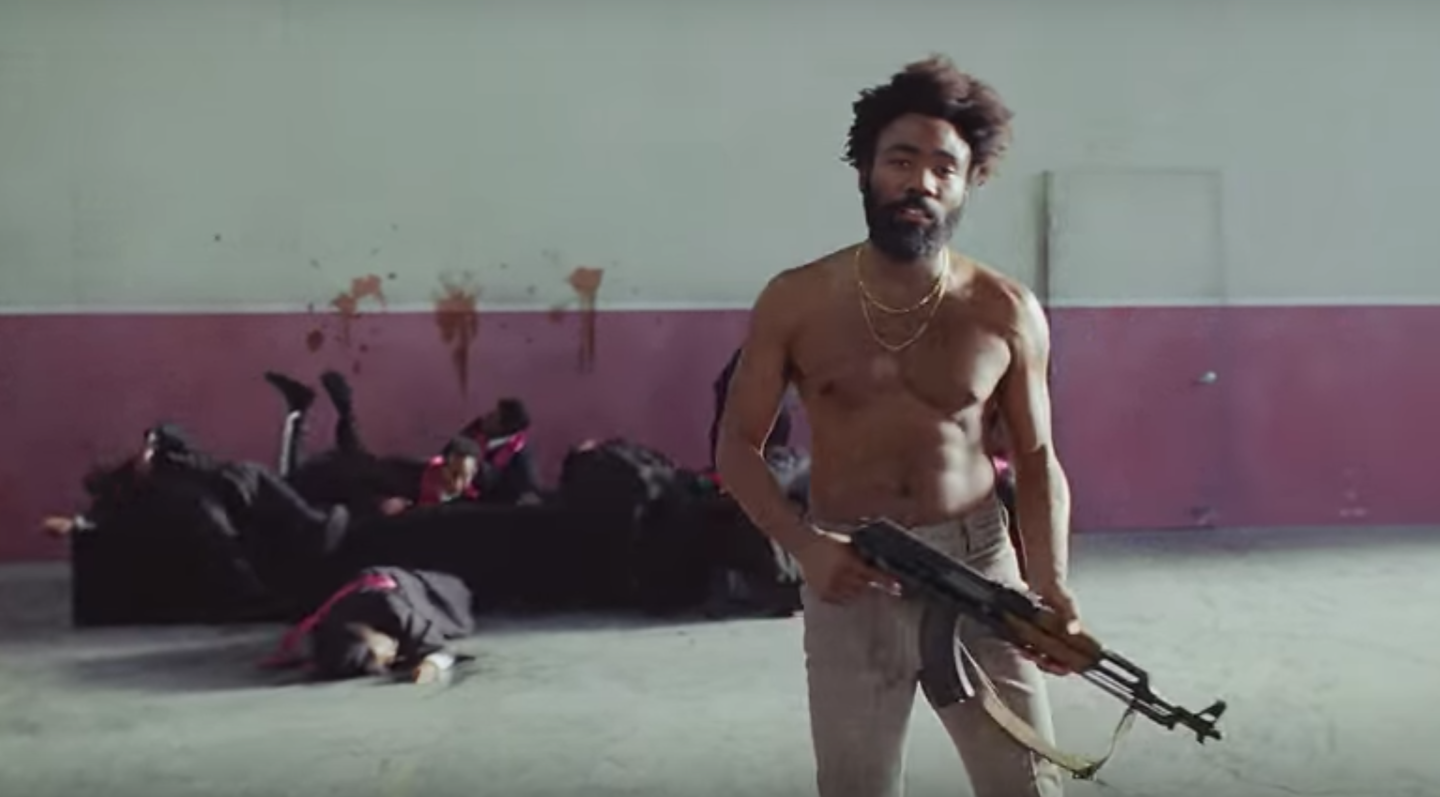While much rightfully deserved ink has been devoted to the bravery of Generation Z and its associated spokespersons (namely Emma González) in the wake of the Parkland shooting, America’s continued aloofness to the “not going to go away” problem of the second amendment hasn’t been half as eye-opening as it is in Childish Gambino’s (a.k.a. Donald Glover’s) latest single and music video, “This Is America” (a not so coded title that means: terrorist nation posing as the hub of liberty and justice for all so long as your sensitivity level is nonexistent).
Premiering the track last night on Saturday Night Live (along with another new one, appropriately called “Saturday”), Childish Gambino created a one-two punch effect by releasing the video today, May 6th, taking the layers of the jubilant tone of the song to new levels as the Hiro Murai-directed video keeps us all “woke” (“Redbone”-style) to how fucked our responses are to the blatant barbarism that has begun at home while we (a.k.a. the “powers that be” known as the government) continue to set our sights on insinuating ourselves into other countries’ “problems” despite the fact that it’s very apparent ours are just as bad if not worse. But America. It’s the promised land–always has been, always will be. Nothing could be wrong here. And a large part of that persistently insidious logic is, in part, how so much of the population continues to shrug off those “pesky” reports of yet another shooting, whether one related to a police officer killing a black man or one pertaining to an angry white boy shooting up a school. Ironically, though the white boy (whether the student or the one who grows into the profession of law enforcement) has nothing to be angry about, his frustration stems from this feeling of his power being taken away. A sentiment that might come on even stronger after seeing this video, for Childish Gambino does not mince metaphors or satire when it comes to expressing what he thinks of the collective’s blatant evasion of the bloodshed that has happened and will continue to happen so long as we have our convenient distractions to numb and nullify reality.
To that point, the entire structure of “This Is America” is designed as one giant divertissement to confuse and obscure attention from what’s actually going on. While there are only two instances in which Childish Gambino, shirtless of course, abruptly shoots his gun (in the first case already in his back pocket, in the second, tossed to him from offscreen), each time is equally shocking in nature for how cavalier and gleeful he is as he does it. What’s more horrifying is the manner in which the guns are handled with extreme care after their use–handed off gently in a towel–while the people shot are either dragged away heartlessly or left to rot altogether.
These abrupt visuals, heightened by Gambino’s own gift for swiftly changing facial expressions (one minute a phony smile, the next an angered sneer), intensify the push and pull of the rhythm of the song between the upbeat admission, “We just wanna party, party just for you/We just want the money, money just for you,” contrasted against the ominous, “Don’t catch you slippin’ up, don’t catch you slippin’ up/Look what I’m whippin’ up/This is America.” And in America, the chaos swirling around you is best overlooked with a little phone interaction here (and yes, there are youths hovering above Gambino looking into their phone as he sways), a little danse macabre there. Anything to shake out the unpleasant thoughts of death encircling you. Kind of like how New York in the 80s was at its most decadent and partying rambunctious primarily because everyone was kicking it from AIDS.
Many of the people dancing in the background of Childish Gambino are also, notably, wearing school uniform type garb. Because not every high school student is feeling as prone to protest and rally as González–some would prefer to simply disregard the pain away. And, in one sense, this American need–fallback coping mechanism–is understandable. We’ve always been the land of the comfortable more than we’ve been the land of the free, ergo the difficulty we have with processing the aftermath of tragedy, tweeting and Facebooking our condolences and prayers before discreetly slipping back into the mantra of “I’m on Gucci/I’m so pretty yeah/I’m gon’ get it/This a celly/That’s a tool”–in short, the disjointed stream of consciousness that populates most of our minds as we shy away from anything “too serious” and focus on that ever constant “American dream” of “Get(ting) your money.”
After the jarring, nonstop barrage of this caustic imagery (that one would like to call a parody, but sadly it is not), a brief intermission in which Childish Gambino lights his joint (another helpful means for forgetting reality) segues into him ascending to the top of a modest 90s era sedan to dance one last time before he himself is chased through the warehouse. The warehouse filled with nothing but “middle class” cars of the past is also a statement in and of itself of never being able to get ahead.
Interpret the symbolism how you will, but it’s pretty clear that what Gambino wants us to know is that you can only turn a blind eye for so long before the pushed aside “predicament” comes toppling down, quite literally chasing you out of the cocoon of abeyance you’ve built for yourself.






















